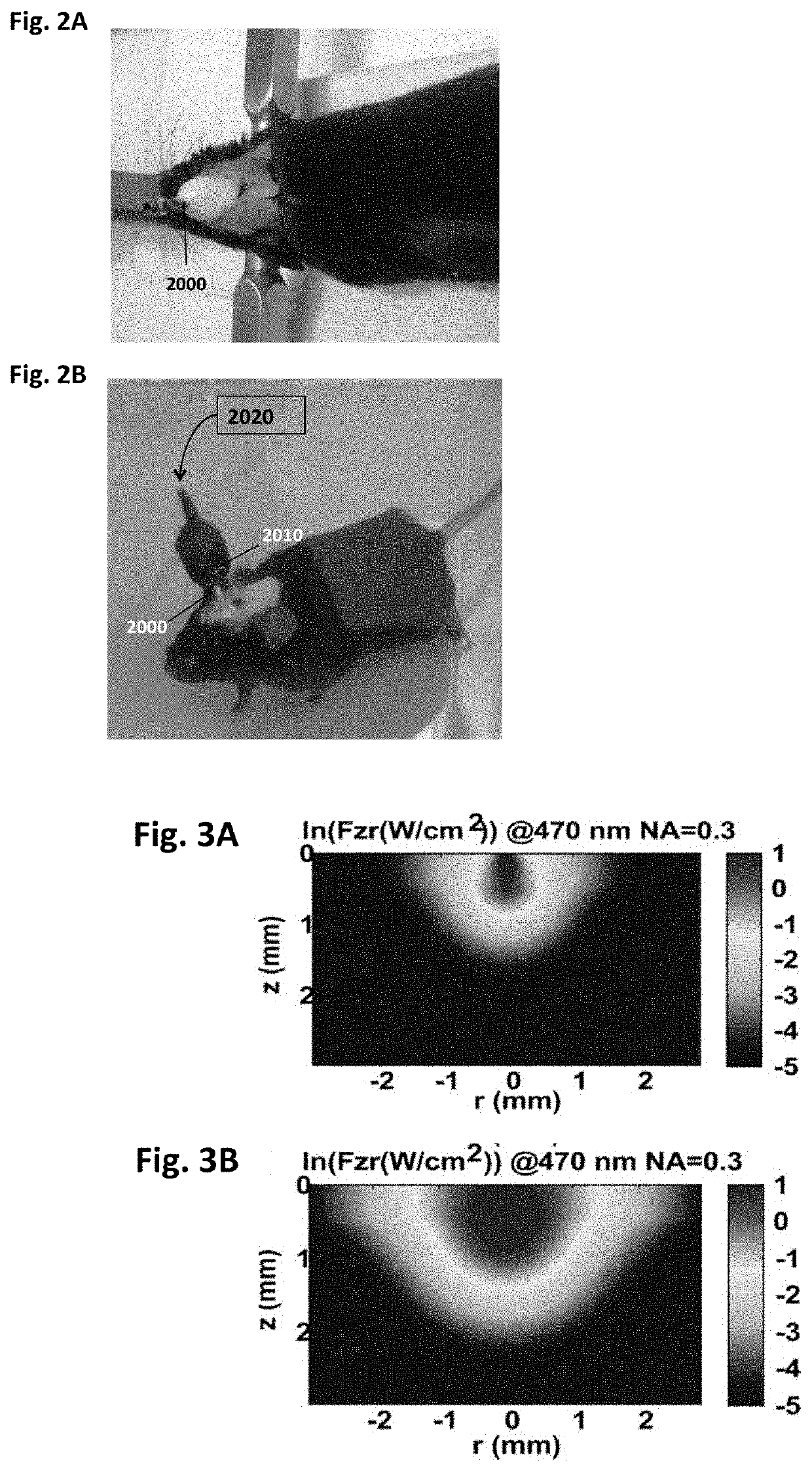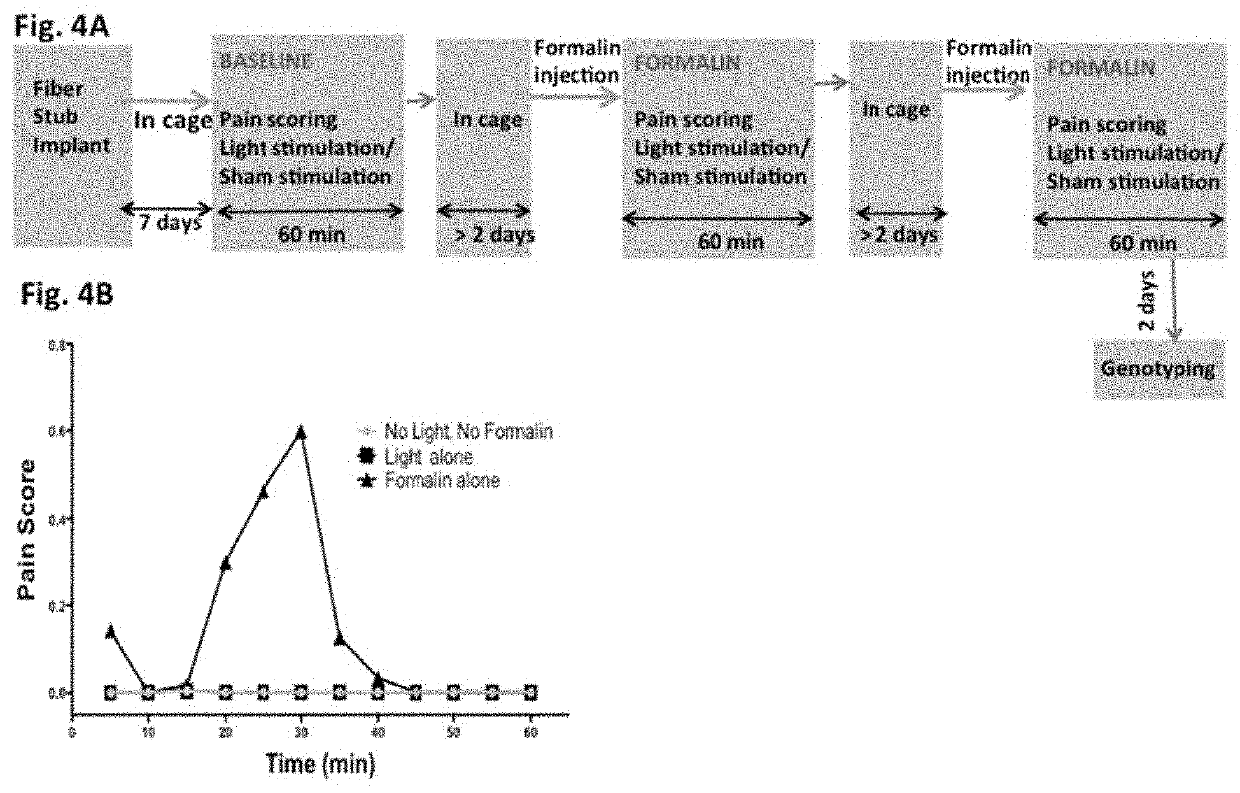Method and device for pain modulation by optical activation of neurons and other cells
a technology of optical activation and neuronal activation, which is applied in the field of optical activation of neurons and other cells to modulate pain. it can solve the problems of opioid dependence, many forms of chronic pain are still resistant to conventional analgesics and drugs, and no single treatment to alleviate different types of pain
- Summary
- Abstract
- Description
- Claims
- Application Information
AI Technical Summary
Benefits of technology
Problems solved by technology
Method used
Image
Examples
example 1
[0065]FIG. 1A illustrates Schematics of pain descending pathway during electrical versus optogenetic stimulation of nervous device. Electrical stimulation used in deep brain stimulation utilizes metal electrode (FIG. 1A) is not specific in stimulating different types of neurons and thus both inhibitory and excitatory neurons are stimulated. With optogenetic stimulation using light delivered by waveguide such as optical fiber, only cell-specific (inhibitory / excitatory) neurons are modulated in targeted Thalamic and other brain regions at tip of the fiber (FIG. 1B). This led to controlled modulation of pain by selective enhancement (+) of the neural circuitries (e.g. Thalamus-PAG-Dorsal horn).
example 2
[0066]FIG. 2A and FIG. 2B show optical neural stimulator used for stimulating thalamic region in mice. The mice (expressing ChR2 in Thalamus) were anesthetized with Ketamine (90 mg / Kg) / Xylaxine (10 mg / Kg). The mice were mounted using Stereotaxic frame, with hair removed from the head. A micro-drill was used to make three holes of size ˜300 μm on the skull, one on top of the thalamus and two for mounting screws. As shown in FIG. 2A, optical fiber stubs (diameter: 200 μm) were stereotaxically inserted and fixed using dental cement. A fiber coupled to LED (emission wavelength: 465 nm) was aligned to couple to the fiber stub for the delivery of light. The stimulating light source (LED) is connected external power supply via lead wires (FIG. 2B) so as to deliver light of controlled intensity, pulse width and frequency.
example 3
[0067]FIG. 3A and FIG. 3B show results of simulation for choice of laser power in order to stimulate specific regions of the Thalamus. In order to determine the parameters for light delivery (e.g. intensity) to the Thalamus in a controlled manner, Monte Carlo (MC) simulation software (BeamMCML) was developed based on the widely used MCML software (36), which is capable of simulating light in multi-layered media. First, collimated point light was considered, and then the convolution method (37) was used to obtain the simulated 470 nm light beam propagation. Briefly, by use of a random number evenly distributed between 0 and 1, the relationship was determined among the random number and a launch radius following a Gaussian probability density function with 1 / e intensity radius. To account for the diverging source, defined by the numerical aperture (NA), the azimuthal angle is determined by a random number uniformly distributed from 0 to 2π and the elevation is determined from another ...
PUM
| Property | Measurement | Unit |
|---|---|---|
| light intensity | aaaaa | aaaaa |
| frequency | aaaaa | aaaaa |
| size | aaaaa | aaaaa |
Abstract
Description
Claims
Application Information
 Login to View More
Login to View More - R&D
- Intellectual Property
- Life Sciences
- Materials
- Tech Scout
- Unparalleled Data Quality
- Higher Quality Content
- 60% Fewer Hallucinations
Browse by: Latest US Patents, China's latest patents, Technical Efficacy Thesaurus, Application Domain, Technology Topic, Popular Technical Reports.
© 2025 PatSnap. All rights reserved.Legal|Privacy policy|Modern Slavery Act Transparency Statement|Sitemap|About US| Contact US: help@patsnap.com



